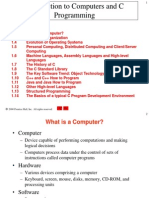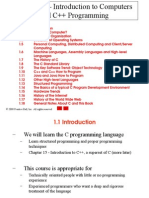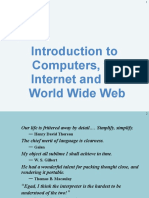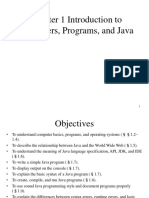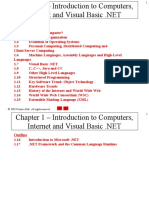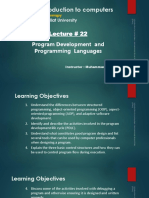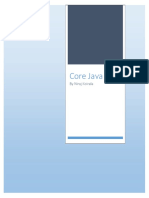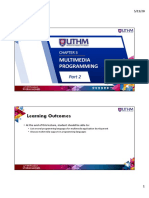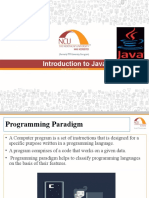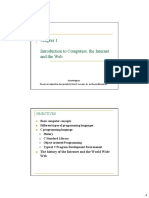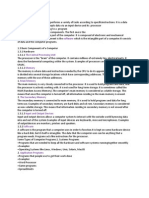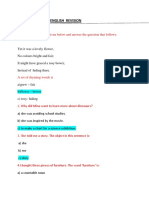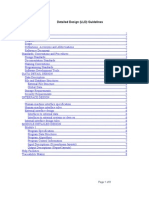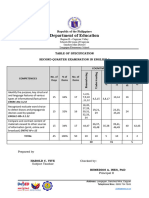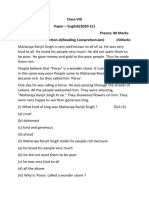Chapter 1 - Introduction to Computers, the Internet, and the World Wide Web
Outline 1.1 Introduction 1.2 What Is a Computer? 1.3 Computer Organization 1.4 Evolution of Operating Systems 1.5 Personal, Distributed and Client/Server Computing 1.6 Machine Languages, Assembly Languages and High-Level Languages 1.7 History of C++ 1.8 History of Java 1.9 Java Class Libraries 1.10 Other High-Level Languages 1.11 Structured Programming 1.12 The Internet and the World Wide Web 1.13 Basics of a Typical Java Environment 1.14 General Notes about Java and This Book
2000 Prentice Hall, Inc. All rights reserved.
1.1 Core of book
Introduction
Program clarity, using both structured and object-oriented programming
Learn structured programming properly, from the beginning
Java
Powerful, object-oriented language Fun to use for beginners, appropriate for experienced programmers Language of choice for Internet and network communications Free implementation at http://java.sun.com
2000 Prentice Hall, Inc. All rights reserved.
1.2 Computer
What is a Computer?
Device for performing computations and making logical decisions Process data using sets of instructions called computer programs
Hardware
Devices comprising a computer Keyboard, screen, mouse, disks, memory, CD-ROM, and processing units
Software
Programs that run on a computer
2000 Prentice Hall, Inc. All rights reserved.
1.3 Computer Organization Six logical units in every computer
Input unit
Gets information from input devices (keyboard, mouse)
Output unit
Sends information (to screen, to printer, to control other devices)
Memory unit
Rapid access, low capacity, stores input information
Arithmetic and logic unit (ALU)
Arithmetic calculations and logic decisions
Central processing unit (CPU)
Supervises and coordinates sections of the computer
Secondary storage unit
Cheap, long-term, high-capacity storage, stores inactive programs and data
2000 Prentice Hall, Inc. All rights reserved.
1.4
Evolution of Operating Systems
Batch processing
Do only one job or task at a time
Operating systems
Manage transitions between jobs Increased throughput - amount of work computers process
Multiprogramming
Many jobs or tasks sharing computer resources
Timesharing
Run small portion of one users job, move onto next user Programs appear to be running simultaneously
2000 Prentice Hall, Inc. All rights reserved.
1.5
Personal, Distributed and Client/Server Computing
Personal computing
Popularized by Apple Computer in 1977
IBM followed suit in 1981 with the IBM Personal Computer
Computers economical enough for personal use Stand-alone units
Distributed computing
Organization has a Local Area Network (LAN)
Computers linked to it
Computing distributed over the LAN
2000 Prentice Hall, Inc. All rights reserved.
1.5
Personal, Distributed and Client/Server Computing
Client/Server computing
File servers offer common programs that client computers access C and C++ popular for writing operating systems, networking, and distributed client/server applications Java used for Internet-based applications
Programming in Java can be more productive than C or C++
2000 Prentice Hall, Inc. All rights reserved.
1.6 Machine Languages, Assembly Languages and High-Level Languages Types of programming languages
1. Machine languages
Strings of numbers giving machine specific instructions Example:
+1300042774 +1400593419 +1200274027
2. Assembly languages
English-like abbreviations representing elementary computer operations (translated via assemblers) Example: LOAD BASEPAY ADD OVERPAY STORE GROSSPAY
2000 Prentice Hall, Inc. All rights reserved.
1.6 Machine Languages, Assembly Languages and High-Level Languages Types of programming languages
3. High-level languages
Similar to everyday English and use mathematical notations (translated via compilers) Example: grossPay = basePay + overTimePay
2000 Prentice Hall, Inc. All rights reserved.
�10
1.7 History of C++ C++ evolved from C
C evolved from two previous programming languages, BCPL and B ANSI C established worldwide standards for C programming
C++ spruces up C
Provides capabilities for object-oriented programming
Objects - reusable software components that model things in the real world
Object-oriented programs easy to understand, correct and modify
2000 Prentice Hall, Inc. All rights reserved.
�11
1.8 Java
History of Java
Based on C and C++ Developed in 1991 for intelligent consumer electronic devices
Market did not develop, project in danger of being cancelled
Internet exploded in 1993, saved project
Used Java to create web pages with dynamic content
Java formally announced in 1995 Now used to create web pages with interactive content, enhance web servers, applications for consumer devices (pagers, cell phones)...
2000 Prentice Hall, Inc. All rights reserved.
�12
1.9 Java Class Libraries Java programs
Consist of pieces called classes Classes contain methods, which perform tasks
Class libraries
Also known as Java API (Applications Programming Interface) Rich collection of predefined classes, which you can use
Two parts to learning Java
Learning the language itself, so you can create your own classes Learning how to use the existing classes in the libraries
2000 Prentice Hall, Inc. All rights reserved.
�13
1.10 Other High-Level Languages A few other high-level languages have achieved broad acceptance
FORTRAN (FORmula TRANslator)
Scientific and engineering applications
COBOL (COmmon Business Oriented Language)
Used to manipulate large amounts of data
Pascal
Intended for academic use
BASIC
Developed in 1965 Simple language to help novices
2000 Prentice Hall, Inc. All rights reserved.
�14
1.11 Structured Programming Structured programming
Disciplined approach to writing programs Clear, easy to test, debug, and modify Pascal designed to teach structured programming
Not used in industrial or commercial applications
Multitasking
Many activities run in parallel C and C++ allow one activity at a time Java allows multithreading
Activities can occur in parallel
2000 Prentice Hall, Inc. All rights reserved.
�15
1.12 The Internet and the World Wide Web The Internet
Developed 30 years ago, funded by the Department of Defense Originally designed to link universities
Now accessible by hundreds of millions of computers
World Wide Web
View multimedia-based documents Internet has exploded
Mixes computing and communication Changes how business is done Information instantly accessible
We cover Java applications that use the Internet
2000 Prentice Hall, Inc. All rights reserved.
�16
1.13 Basics of a Typical Java Environment Java Systems
Consist of environment, language, Java Applications Programming Interface (API), class libraries
Java programs have five phases
Edit
Use an editor to type Java program vi or emacs, notepad, Jbuilder, Visual J++ .java extension
Compile
Translates program into bytecodes, understood by Java interpreter javac command: javac myProgram.java Creates .class file containing bytecodes (myProgram.class)
2000 Prentice Hall, Inc. All rights reserved.
�17
1.13 Basics of a Typical Java Environment Java programs have five phases (continued)
Loading
Class loader transfers .class file into memory
Applications - run on user's machine Applets - loaded into Web browser, temporary Classes loaded and executed by interpreter with java command java Welcome HTML documents can refer to Java Applets, loaded into web browsers To load, appletviewer Welcome.html appletviewer minimal browser, can only interpret applets
2000 Prentice Hall, Inc. All rights reserved.
�18
1.13 Basics of a Typical Java Environment Java programs have five phases (continued)
Verify
Bytecode verifier makes sure bytecodes are valid and do not violate security Java must be secure - possible to damage files (viruses)
Execute
Computer interprets program one bytecode at a time Performs actions specified in program
Program may not work on first try
Make changes in edit phase and repeat
2000 Prentice Hall, Inc. All rights reserved.
�Phase 1
Editor
Disk
Program is created in the editor and stored on disk. Compiler creates bytecodes and stores them on disk.
19
Phase 2
Compiler
Disk Primary Memory
Phase 3
Class Loader Class loader puts bytecodes in memory. . . . . . . Primary Memory Bytecode verifier confirms that all bytecodes are valid and do not violate Javas security restrictions.
Disk
Phase 4
Bytecode Verifier
Phase 5
Interpreter
. . . . . . Primary Memory
2000 Prentice Hall, Inc. All rights reserved.
. . . . . .
Interpreter reads bytecodes and translates them into a language that the computer can understand, possibly storing data values as the program executes.
�20
1.14 General Notes about Java and This Book Java
Powerful language Programming notes
Clarity - Keep it Simple Portability - Java very portable, but it is an elusive goal
Some details of Java not covered
http://java.sun.com for documentation
Performance
Interpreted programs run slower than compiled ones Compiling has delayed execution, interpreting executes immediately Can compile Java programs into machine code Runs faster, comparable to C / C++
2000 Prentice Hall, Inc. All rights reserved.
�21
1.14 General Notes about Java and This Book Just-in-time compiler
Midway between compiling and interpreting
As interpreter runs, compiles code and executes it Not as efficient as full compilers Being developed for Java
Integrated Development Environment (IDE)
Tools to support software development Several Java IDE's are as powerful as C / C++ IDE's
2000 Prentice Hall, Inc. All rights reserved.



